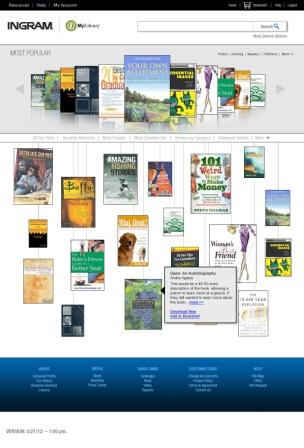(This article is part of Library Journal’s ongoing series looking at various ebook platforms available to public libraries.)
Ingram Content Group, one of the dominant players in the academic ebook market with its MyiLibrary platform, has been gearing up for several months to introduce MyiLibrary to the public library market. The launch date is now scheduled for September, but at the American Library Association annual conference this week in Anaheim Ingram will be demonstrating how it is tailoring the platform and its content to serve the public library channel (booth #1446).
“Toward the end of 2011 we decided the time was right to get into the public library sphere,” said Richard Rosy, Ingram’s vice president and general manager for library services. “This platform is very strong in the academic community around the world, and we decided it was time to go to public libraries with it.”
Like other major com panies such as EBSCO (Ebooks on EBSCOhost) and Baker & Taylor (Axis 360), Ingram realized that leaving Cleveland-based OverDrive, the dominant ebook vendor for public libraries, an open playing field was no longer the way to go. Rosy said the company carefully watched as the demand among public libraries steadily grew over the past few years, to the point where Ingram saw the same commitment to the format that they had long seen in the academic community.
panies such as EBSCO (Ebooks on EBSCOhost) and Baker & Taylor (Axis 360), Ingram realized that leaving Cleveland-based OverDrive, the dominant ebook vendor for public libraries, an open playing field was no longer the way to go. Rosy said the company carefully watched as the demand among public libraries steadily grew over the past few years, to the point where Ingram saw the same commitment to the format that they had long seen in the academic community.
“With the advent of all the devices and people coming into public libraries looking for ebook content, the time was right,” Rosy said. “Librarians were really starting to ask our reps, ‘Do you have ebooks?’ “
Ingram’s ambition with MyiLibrary is to have it be as strong in the public space as it is in the academic space, Rosy said.
“The opportunity for libraries to have more than one provider is really important because they need choices,” Rosy said. “The content is going to end up being the same. It’s really about the services and ease of use of the platform — how easy is it to download, how many steps is it— those are the kind of things we think we excel at,” he said.
Over the past six months, Ingram has been reconfiguring the MyiLibrary interface to make it more user friendly for public library patrons, and it also has been diversifying the 300,000 plus titles in the collection to include more popular content. Similar to the challenges that EBSCO has faced with its transformation of the old NetLibrary into Ebooks on EBSCOhost, Ingram has to diversify a collection that presently slants toward scholarly content.
“One of the strengths we have as Ingram is that we’ve got a large group of content acquisition associates who do nothing except call on publishers to secure electronic content,” Rosy said. “Six months ago we told them we need public library material as well.”
 Ingram scours through the millions of titles in Core Source, its digital asset management and distribution system that publishers use as a repository, as well as the company’s print-on-demand business unit Lightning Source to determine if there are titles that might work well in the public library channel.
Ingram scours through the millions of titles in Core Source, its digital asset management and distribution system that publishers use as a repository, as well as the company’s print-on-demand business unit Lightning Source to determine if there are titles that might work well in the public library channel.
“We manage the publishers’ inventory and if we see content relevant to the public library market but which the publisher hasn’t offered yet, we go to the publisher and ask them if they are interested in exposing the content to public libraries,” Rosy said.
Many university presses are available through the platform, including a handful added just this week: Duke University Press, Princeton University Press, University of Michigan Press, Vanderbilt University Press, and the University of California Press. But others publishers that use the platform include McGraw-Hill, John Wiley, Encyclopedia Britannica, Rough Guides, Prentice Hall, F&W Media and others. A more detailed list of featured publishers is at the end of this article.
“We have a good amount of public library titles in our collection — Wiley travel books, Dummy guides, cookbooks, romance,” Rosy said. “So our attitude now is to go out and get more public library content.” He added that the collection’s reference material could prove attractive to public libraries. Reference is also a strong point for ebrary’s Public Library Complete and Gale’s Virtual Reference Library.
Ingram is negotiating with the Big Six publishers, but has not yet finalized any contracts, and the company will have a lot of ground to make up if it is going to catch OverDrive in the area of highly coveted front-list popular trade fiction—a task further complicated by the publisher-imposed restraints in that area (see A Guide to Publishers in the Library Ebook Market).
The company is also working on the platform itself, which is well tested in the academic market, so that both the content and the technology will be primed once they enter the public library market. They are reaching out to libraries to prep them.
“It’s an educational phase right now,” said Marcus Roberson, the director of sales for library services. “You market to people and educate them about the offerings you have and the technology direction that you are going in so that when the content hits and we load it and offer it they are ready and understand how the platform works,” he said.
The platform will require jumping interfaces, which is not what a lot of librarians are demanding, but Roberson said Ingram is working with numerous vendors of integrated library systems to achieve via web services the more seamless experience librarians want.
“What they want to do is have an experience for the patron where they find something in the catalog and get it, rather than have to go through so many steps that people get tired half way through and don’t complete the process,” Roberson said. “We don’t want them to get frustrated. We want to be able to offer up to the ILS companies the ability to come and get the information out of our system [such as circulation statistics] in a seamless manner so that it keeps that experience at the library level. The fewer the clicks the better.”
To date, Polaris and 3M are the only companies to achieve such an integration, although OverDrive is scheduled to release its first set of APIs in July..

Richard Rosy, vice president and general manager, Ingram Content Group library services
Ingram offers a one-step authentication process and free MARC records within 72 hours that provide a link out to the Ingram platform, according to Kelly Clifton, a sales representative.
And Ingram also offers an ordering interface called iPage (a public counterpart to Oasis on the academic side) that allows one-stop shopping for electronic and print material, a feature many librarians desire. Baker & Taylor announced a similar feature recently for its Title Source 3 ordering platform.
“We’ve had a dual print/electronic portal for two years in the academic community. So, we built it and we know how to do it,” Rosy said. “Today, on our platforms, they pick the content they want and then they get a list of the different formats and they have the choice of all the formats in front of them. We’re proud of that.”
Ingram has set the platform fee at $500, which is relatively inexpensive compared to OverDrive and which Rosy said might make Ingram a more attractive option among small or rural libraries. But it is still more than EBSCO, which charges no platform fee, or a service like Freading, from Library Ideas, which offers a collection of 20,000 plus titles on a pay-per-use model for a $150 startup fee (or no charge for libraries already subscribing to the company’s Freegal music service)..
The lending models for the public library version of MyiLibrary are one-book, one-user, and also a model that allows three simultaneous users if the library pays about 165 percent of the title’s retail price. Ingram also will work with public libraries to set up patron-driven acquisition (PDA) profiles.
“We do PDA in a big way and we are definitely going with PDA in the public sphere as well,” Rosy said.
The formats are PDF and epub, and downloads are available via Adobe Digital Editions (ADE) to all major devices except Kindle, although Kindle Fire is compatible. If the patron has a wireless connection, they can access the title directly without ADE. There is also a browser-based reader available.
“It’s an integrated approach to content in all its forms, and the tools we put in front of the user are going to be seamless,” Rosy said. “We are all going to end up with the same content so then it’s all about the services, the ease of use, the acquisition plans and we’ve proven that we are capable of delivering all of those things.”


